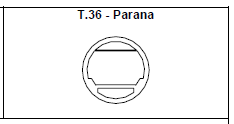Parana (Hernandias) Tunnel
TOTAL IMMERSED LENGTH: 2,367 m
DEPTH AT BOTTOM OF STRUCTURE: 32 m
HEIGHT: 10.8 m
WIDTH: 10.8 m
ENVIRONMENTAL CONDITIONS: Design current: 1.35 m/s
FABRICATION METHOD: A casting basin, designed for nine cycles, was excavated. Four elements were produced on a three-month cycle. The basin was 156 m long, 46 m wide, and 13 m high. The dock was closed by a 15 m high, 23 m dia floating cylindrical caisson acting against two fixed cylindrical tanks with 50 cm wall thickness.
DEPTH AT BOTTOM OF STRUCTURE: 32 m
HEIGHT: 10.8 m
WIDTH: 10.8 m
ENVIRONMENTAL CONDITIONS: Design current: 1.35 m/s
FABRICATION METHOD: A casting basin, designed for nine cycles, was excavated. Four elements were produced on a three-month cycle. The basin was 156 m long, 46 m wide, and 13 m high. The dock was closed by a 15 m high, 23 m dia floating cylindrical caisson acting against two fixed cylindrical tanks with 50 cm wall thickness.
Between Santa Fe and Parana,
Argentina

Argentine government
Consortium of Hochtief AG, Vianini SpA and Sailav SA
Consortium of Hochtief AG, Vianini SpA and Sailav SA
36 - 65.4 m (one 10.75 m element was used on the Parana side)
2,367m
32m
Project construction
1969-05-01
37
One tube; two lanes
10.8m
10.8m
Light elements, filled with water to induce final settlement, were held down with six outrigger
pockets each. Backfill was vibrocompacted around the element. A jack-up barge was used for
element and locking fill placement. Partial ballasting was accomplished by filling between light end
bulkheads and interior bulkheads (the latter capable of taking submerged water pressure), spaced
at 13-m intervals. The exterior bulkheads could be detached and floated to the dock for reuse.
pockets each. Backfill was vibrocompacted around the element. A jack-up barge was used for
element and locking fill placement. Partial ballasting was accomplished by filling between light end
bulkheads and interior bulkheads (the latter capable of taking submerged water pressure), spaced
at 13-m intervals. The exterior bulkheads could be detached and floated to the dock for reuse.
A casting basin, designed for nine cycles, was excavated. Four
elements were produced on a three-month cycle. The basin was
156 m long, 46 m wide, and 13 m high. The dock was closed by
a 15 m high, 23 m dia floating cylindrical caisson acting against
two fixed cylindrical tanks with 50 cm wall thickness.
elements were produced on a three-month cycle. The basin was
156 m long, 46 m wide, and 13 m high. The dock was closed by
a 15 m high, 23 m dia floating cylindrical caisson acting against
two fixed cylindrical tanks with 50 cm wall thickness.
Design current: 1.35 m/s
Model tests were made. The element was first brought to the site parallel to the current to the
centerline of the tunnel, using six 465-HP pusher rigs mounted on flexifloats. Two other similar
elements were used to guide the element parallel to the current. At the jack-up rig, the element was
turned transverse to the current using winches mounted on pontoons. A trolley running under the
platform of the jack-up rig moved the element to its final position. It was then handled by four
vertical and horizontal winches of the jack-up rig. Two ballast chambers under the roadway on both
sides of the interior bulkheads were filled with water to produce 150 tons of negative buoyancy
centerline of the tunnel, using six 465-HP pusher rigs mounted on flexifloats. Two other similar
elements were used to guide the element parallel to the current. At the jack-up rig, the element was
turned transverse to the current using winches mounted on pontoons. A trolley running under the
platform of the jack-up rig moved the element to its final position. It was then handled by four
vertical and horizontal winches of the jack-up rig. Two ballast chambers under the roadway on both
sides of the interior bulkheads were filled with water to produce 150 tons of negative buoyancy
A tremie concrete joint using inflatable gaskets was used for all
elements. A bottom slab was used to form the tremie. Concrete
hoods and collars were used.
elements. A bottom slab was used to form the tremie. Concrete
hoods and collars were used.
4 mm preformed three-layer glass-fibre reinforced polyester resin waterproofing all around the
cylinder. No protection was used.
cylinder. No protection was used.
Sand fill was compacted around each element, using deep compactors.
4.0 m of compacted sand fill
Reinforced

